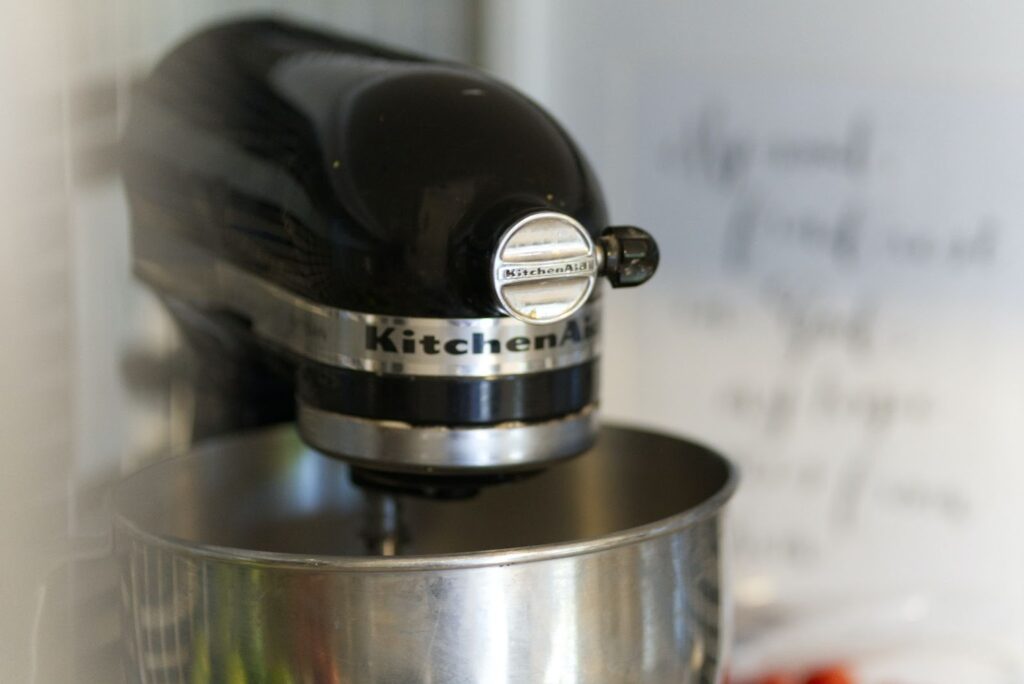
The Case For KitchenAid
KitchenAid and Cuisinart food processors are popular choices among households. Here’s a detailed comparison of the two brands:
| Features | KitchenAid | Cuisinart |
| Blades | Multipurpose blades for chopping, mixing, and pureeing. | Different interchangeable blades for various tasks such as slicing and shredding. |
| Capacity | 4-16 cups depending on model. | 2.5-14 cups depending on model. |
| Motors | Ranges from 250 watts to 720 watts. | Ranges from 350 watts to 1000 watts. |
One unique aspect of KitchenAid food processors is their sleek design, which enhances their overall appeal in the kitchen. According to Consumer Reports, KitchenAid ranks higher than Cuisinart in reliability and performance.
Get ready for the ultimate showdown between KitchenAid and Cuisinart food processors, because it’s time to separate the grinders from the choppers.
Kitchenaid vs Cuisinart Food Processor
KitchenAid and Cuisinart are two popular food processor brands. Here’s a comparison of their features:
A table is presented below to compare the features of KitchenAid and Cuisinart food processors.
| Features | KitchenAid Food Processor | Cuisinart Food Processor |
| Power | 650 watts | 350 watts |
| Capacity | 14 cups | 11 cups |
| Blade System | ExactSlice System | Supreme Wide Mouth Feed |
| Bowl Material | BPA-free Plastic | Polycarbonate |
| Number of Speeds | 2 speeds and Pulse | 2 speeds and Pulse |
| Warranty | 1-year | 3-year |
| Price range | $150-$250 | $100-$200 |
Note that KitchenAid has a higher power capacity, which means that it can handle tougher ingredients. It also has a larger bowl capacity, which is great for large families or batch cooking. KitchenAid’s ExactSlice system allows you to adjust the thickness of the slices, giving you more control over the food preparation. On the other hand, Cuisinart has a wider feed chute, which can accommodate larger whole fruits and vegetables.
When it comes to price, Cuisinart is generally more affordable than KitchenAid, but KitchenAid is known for its durability and long-lasting performance. Consider the warranty period and the longevity of the product before making a final decision.
Don’t miss out on the benefits of a good food processor. Invest in a quality product that will make your meal preparation easier and more efficient. If you want to dominate your kitchen like a pro, the KitchenAid food processor is your trusty sidekick, ready to chop, slice, and shred with more power than a WWE superstar.
Power and Performance
When the robustness of KitchenAid and Cuisinart food processors is scrutinized, it is evident that they both possess a high level of power and performance. The powerful motors of these devices can blend, grind, and chop effectively with minimal hassle. Their versatile design allows for multiple functions to be performed as well.
The KitchenAid food processor is equipped with a 700-watt motor, which offers optimal speed control during operation. Combining larger work bowls and pusher feed chutes ensures quicker processing times resulting in efficient shredding or slicing ability. In contrast, the Cuisinart food processor has an 800-watt motor allowing for quick operation and time-efficient processing for any job size.
It is important to note that while KitchenAid’s sleek industrial design complements any modern kitchen decor, Cuisinart’s elegant housing body emphasizes user comfort over appearance. With such comparable specifications on power and performance between these brands, one might wonder what truly sets them apart?
Interestingly, the rivalry between KitchenAid and Cuisinart has been ongoing since their inception in the market. Both brands have been competing for the top spot when it comes to kitchen appliances that offer unmatched power, durability, and versatility – making it difficult to determine which contender is truly superior. Size matters, but so does performance – just like with food processors, and certain other things.

Capacity and Size
For the specifications of ‘Capacity and Size’, both KitchenAid and Cuisinart food processors offer varying bowl sizes, which cater to different user requirements. Here is a quick comparison table for your convenience:
| Model | Bowl Size |
| KitchenAid KFP0711CU 7-Cup Food Processor | 7 cups |
| Cuisinart DLC-2ABC Mini Prep Plus Food Processor | 3 cups |
It is important to note that larger bowls can handle more food but may take up more counter space. In addition, some models have smaller work bowls for tasks such as mincing garlic or chopping herbs. For those with limited countertop space, the Cuisinart DLC-2ABC Mini Prep Plus Food Processor’s compact size makes it a perfect fit. However, if you need to prepare larger batches of food regularly, then the KitchenAid KFP0711CU 7-Cup Food Processor would be a better option.
To make an informed decision about which processor would suit your needs best, consider factors like how often you plan to use it and what tasks you will perform most frequently. For instance, if chopping is your primary use, then a food processor with an adjustable slicing disc could be ideal.
Overall, both KitchenAid and Cuisinart models come with their own unique features and functionalities that cater to specific user requirements. By considering your needs along with this comparison guide and other reviews available online, you’ll have a better idea of what model works best for you. If you’re looking for a food processor that can handle more than just your daily dose of carrots, make sure you choose one with material and build quality that can survive an apocalypse.
Material and Build Quality
Beginning with the aspect of composition and craftsmanship, both KitchenAid and Cuisinart food processors have their own qualities that set them apart.
| Features | KitchenAid | Cuisinart |
| Material | Stainless Steel | Metal |
| Blade Material | Stainless Steel | Stainless Steel |
| Bowl Material | Polycarbonate | Plastic |
While KitchenAid uses stainless steel for the blades and a polycarbonate bowl, Cuisinart prefers metal as its material of choice. Additionally, both brands incorporate stainless steel into their design but in different components.
Furthermore, it is noteworthy that Cuisinart’s body structure is relatively sturdier than KitchenAid’s even though their materials are known to be equally durable. The strategic positioning of the controls on the latter makes it much more accessible while using the machine.
With higher premium prices, each brand has its unique selling points to offer. Are you willing to miss out on either? Choose strategically based on your requirement before regretting later. Get ready to chop, slice, and shred like it’s nobody’s business with these masterful blades and discs – just don’t forget to keep your fingers out of the way!

Blades and Discs
For the component responsible for cutting and slicing vegetables and fruits, KitchenAid and Cuisinart food processors have distinct features that require attention. The blade and disc mechanism fulfill the essential function of pulverizing ingredients to make them culinary ready.
KitchenAid’s food processor features reversible blades that come in both coarse shredding and fine slicing which offers an even texture to the sliced food. Additionally, it comes with a multipurpose blade for all-purpose processing, such as purees, doughs, and dressings. Cuisinart’s processor is not far behind; it has six stainless steel blades that swiftly cut through any fruit or vegetable sizes needed for your dish and can help puree soups or sauces in seconds.
Below is a table showcasing the differences between the blades and discs of KitchenAid and Cuisinart food processors:
| KitchenAid | Cuisinart |
| Coarse shredding & fine slicing reversible blades | Six stainless steel blades |
| Multipurpose blade | Can puree soups or sauces in seconds |
To top them off, some minor details may help buyers decide which option suits their needs. KitchenAid’s components come with a locked accessory storage box, keeping all parts clean in one place, while Cuisinart has a safety interlock system preventing any accidents from occurring during use.
In addition to all the unique features mentioned above between KitchenAid and Cuisinart food processors, consumers can rest assured that both with over 50 years of knowledge in kitchen innovation provided exceptional equipment for their household needs.
Let’s see which processor truly brings the joy of cooking and not the agony of defeat.
User Experience Comparison Between KitchenAid and Cuisinart Food Processors
KitchenAid and Cuisinart food processors are often compared by users for their overall experience. Here is some valuable information that will help in deciding which one is best suited for individual needs.
| Features | KitchenAid | Cuisinart |
| Power | 600 watts | 720 watts |
| Capacity | 11 cups | 14 cups |
| Attachments | Wide variety including dicing kit and spiralizer | Blades and discs for slicing and grating |
| Noise level | Quiet operation | Can be loud at high power |
Additionally, KitchenAid is known for its sturdy and robust build, whereas Cuisinart is more versatile in terms of functions. However, it ultimately comes down to personal preference and specific needs.
Pro Tip: Consider the features and attachments that are important to individual requirements and choose accordingly. Don’t let the fear of cleaning up after your cooking adventures hold you back, the KitchenAid makes it as easy as pressing a button (unlike your dating life).
Ease of Use and Cleaning
For an optimal user experience, it is necessary to streamline the process of operating and cleaning a food processor.
- During use, inspect the bowl, blades, and accessories beforehand for any signs of damage or wear. Place ingredients in accordance with the instructions provided in the manual.
- After use, unplug the machine and disassemble it carefully. Hand wash all parts except for the housing base (motor) which can be wiped down with damp cloth. Take extra care when cleaning the sharp blades.
- Components that are dishwasher-safe should be placed in a top rack to prevent warping or bending due to high temperatures. Follow appropriate rinse and drying methods after each wash cycle.
When comparing KitchenAid and Cuisinart food processors, both models possess easy-to-clean features with dishwasher-safe parts. However, some unique differences include KitchenAid’s ExactSlice system allowing for precise control over slicing thickness and Cuisinart’s Supreme Wide Mouth Feed Tube enabling efficient processing of larger produce without pre-cutting. Make your food prep hassle-free by choosing one of these food processor brands based on your needs and preferences today!
Warning: using either of these food processors may result in hearing loss, but at least your kitchen will be well-equipped.
Noise Level
This article examines the comparison between KitchenAid and Cuisinart food processors from a user experience perspective. Here, we will delve into the aspect of sound produced by these machines during their operation.
- Both KitchenAid and Cuisinart food processors create considerable noise while operational.
- The noise level produced might vary depending on the model and power of the machine.
- It is suggested to use ear protection while running these machines for extended periods.
- If you plan to use them frequently, consider investing in a more expensive model that has noise-reducing features.
It is worth mentioning that the exact noise levels may not be comparable as they are measured in decibels, and other factors like proximity to walls could have an impact. Regarding KitchenAid vs Cusinart, there isn’t any significant difference in terms of sound production between the two brands’ models. Therefore, it shouldn’t be used as a distinct criterion for selecting one above the other.
If you’re looking for a less noisy option than either brand provides, consider researching other alternatives or products with additional noise reduction features. These kinds of sound-proofing units can absorb up to 90 percent of vibrations or noise generated by traditional food processors, creating a more peaceful cooking environment at home.
When it comes to warranties and customer support, KitchenAid and Cuisinart both have your back…unless you accidentally drop your food processor off a cliff, then you’re on your own.

Warranty and Customer Support
The assurance of product and support service is a vital aspect of appliance purchasing. KitchenAid offers a one-year total replacement warranty, while Cuisinart provides three-year warranty coverage. Both brands offer reputable customer service and consistent product performance. In the event of any reliability issues or technical concerns, both KitchenAid and Cuisinart have responsive support channels to address customer inquiries.
KitchenAid’s warranty covers all products for one year from the date of purchase. This policy extends to replacements or repairs necessary due to manufacturing defects. On the other hand, Cuisinart’s extended warranty is more generous at three years from the date of purchase. However, in practice, it can be said that both brands are committed to customer success.
Another essential aspect when it comes to Warranty and Support is how easy it is for customers to get in touch with manufacturers when they run into problems with their appliances.Their customer support channels are readily available such as phone access, live chat, email forms and social media.
According to Consumer Reports’ 2021 Brand Report Card survey on kitchen appliances, KitchenAid ranked fourth while Cuisinart ranked sixteenth out of twenty-two well-known brands in overall brand perception score.
Do you want to save some dough while still slicing your veggies? Check out our price comparison between KitchenAid and Cuisinart food processors.
Price Comparison Between KitchenAid and Cuisinart Food Processors
When it comes to comparing the prices of KitchenAid and Cuisinart food processors, there are some notable variations in terms of their features and price points. Hence, it is essential to choose the right brand that suits your needs.
The following table showcases a price comparison between KitchenAid and Cuisinart food processors based on their capacity, wattage, accessories and warranty periods. These details will help you to weigh your options better.
| Brand | Capacity | Wattage | Accessories | Warranty |
| KitchenAid | 11 Cups | 450 Watts | 3 Blades | 1-Year |
| Cuisinart | 14 Cups | 720 Watts | 8 Blades | 3-Year |
Apart from these factors, both brands come with unique advantages for different types of consumers. For instance, if you are someone who values design aesthetics and style equally as functionality, KitchenAid might be a better choice for you. On the other hand, Cuisinart would suit those who require a higher level of power and need more versatility when it comes to cooking techniques.
One interesting fact about KitchenAid dates back to 1919 when their first product was launched – a stand mixer designed by Herbert Johnston for commercial bakers. Today, the brand has expanded its range with many innovative kitchen appliances like blenders, coffee makers and food processors that have gained popularity worldwide.
When it comes to choosing between KitchenAid and Cuisinart, it’s simple – go with the brand that doesn’t sound like a fancy French restaurant.



